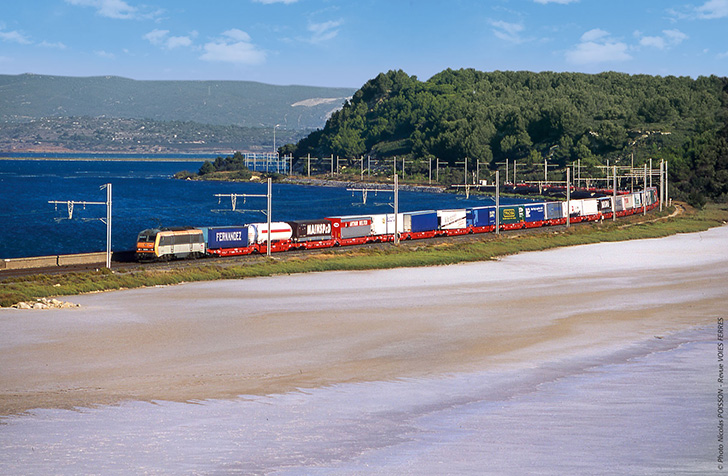
A study conducted by Fomento confirms the profitability of rail motorways systems. According to the report, the Lohr system is the most appropriate and competitive long-distance intermodal service.
The Spanish Ministry of Public Works has confirmed the cost-effectiveness of rolling highways in Spain. This is thanks to a study on the development of rolling highways, which El Vigía gained access to, that is part of the Ministry’s Logistics Strategy. The report says that the most efficient model would be the unaccompanied Lohr, whose level of efficiency in terms of the ratio of net tonnes to gross tonnes is 48%. The Lohr model is closely followed by the Poche wagon system (with 47% efficiency), which uses gantry cranes to vertically move articulated lorries and place them on the train wagons. Finally, the Rola model of small-wheeled wagons was ruled out. With this model, the lorry cab and trailer get on the train together using a ramp.
The study found that the most profitable routes would be the Vitoria, Spain-Dourges, France route for international service and the Madrid-Barcelona route for domestic service. The Ministry of Public Works worked from the assumption of capturing 10% of suitable motorway traffic. According to the study, the Madrid-Barcelona and Madrid-Seville domestic routes were those with the highest demand for Spanish rail connections, with projections of 48,180 and 21,900 annual vehicles respectively.
The study shows that, of the various possible connections, international rolling highways have a higher exploitable demand than rolling highways within Spain. The percentages of traffic capture for the weakest routes were around 10% among international connections. ‘This modal distribution is in agreement with the reality observed for rolling highway service in France,’ the document states. Specifically, the routes with the greatest amount of traffic would be Vitoria-Dourges (with forecast demand of 130,670 vehicles per year), Vitoria-Paris (126,290 vehicles per year), and Barcelona-Bettembourg (92,710 vehicles per year). International service along the Mediterranean coast would require different numbers of trains depending on the destination and the technology used. For the Barcelona-Bettembourg route, four trains per day in each direction would be needed for the Lohr model, versus five daily trains per direction with the Poche technology. As for international service along the Atlantic coast, the Vitoria-Dourges route would require six trains per day in each direction.
The Madrid-Barcelona route would capture the greatest volume of demand at the domestic level, requiring two trains per day in each direction for the unaccompanied Lohr model and three trains per day for the Poche wagons. On the Madrid-Seville route, only one train per day in each direction would be necessary for both technologies due to the lower volume of exploitable demand.
The study notes that the minimum railway distance for transporting unaccompanied vehicles on rolling highways should be between 800 and 1,000 kilometres, and it is essential that there be ‘good access’ to motorways. Indeed, the terminals should be located near major motorways, rather than in very industrialised or concentrated areas. Additionally, the Ministry of Public Works found that the length of trains ‘strongly influences the efficiency and cost-effectiveness of rolling highway service,’ with a recommended train length between 750 and 1,000 metres.
The analysis of sensitivity of demand to price showed that captured traffic would vary greatly depending on the price. For example, in the case of the Vitoria-Paris corridor, captured traffic would go up 19.4% with a 10% reduction in price, while captured traffic would go down 16.8% with a 10% increase in price. The report concludes that transport companies may find acceptable prices to be between €0.70 and €0.90 per kilometre per vehicle for domestic transport and between €0.80 and €1.10 per kilometre per vehicle for international rolling highways.
Finally, the analysis showed that service with intermediate stops would see a decreased percentage of captured traffic and, as such, would see less traffic than direct service. The reason for the lower level of traffic captivation for service with intermediate stops is mainly related to the increased transport time (from changing tracks and transferring cargo) and the increased likelihood of incidents. Also, the study found that the transport distance to the terminal considerably influences the competitiveness of a rolling highway, with a longer distance significantly reducing the amount of demand captured.
The Logistics Unit study concluded that the unaccompanied transport modes, both from Poche and Lohr, made the best usage of the train because they do not require a compartment for drivers, nor space on the wagons for the lorry cabs. Of the two systems, the Ministry of Public Works found that the Lohr model is more efficient.
The study estimated that the investment necessary for developing two Lohr terminals, one at each end of a domestic rolling highway route, would be €66.9 million. This cost includes the purchase of land, a loading and unloading area, a parking area, roads with pull-off areas, two handling vehicles, and, in the case of the Poche system, gantry cranes. For Poche system terminals, the necessary investment would be €55 million.
In terms of necessary investment in rolling stock, for domestic service, the study pointed to a class 252 locomotive with a unit cost of €4.2 million, and for international service, a modified class 252 locomotive valued at €5 million. The cost of Lohr wagons for unaccompanied service is €444,519 per unit, while the Poche wagons cost €84,097 per unit. The difference in cost of rolling stock is not only based on the purchase price of each type of wagon. The cost difference is also related to the operating costs for each model (loading and unloading times, net load, etc.).
Lastly, after analysing the opinions of different panels of experts on rolling highways, the report concludes that these services should be, above all, competitive in terms of pricing compared to the cost of transport via motorway. ‘It is an issue of financial cost, and external costs associated with motorway transport should not be added to the equation,’ the study states. It also stresses that the reliability and quality of service must be excellent, with sufficient frequency. The study notes that rolling highways need to adapt to the trends of motorway transport. Indeed, the study looked at how calculations of traffic and efficiency of service would vary if the maximum weight of lorries were to increase from 40 to 44 tonnes in Spain.
Source: El Vigia.com


